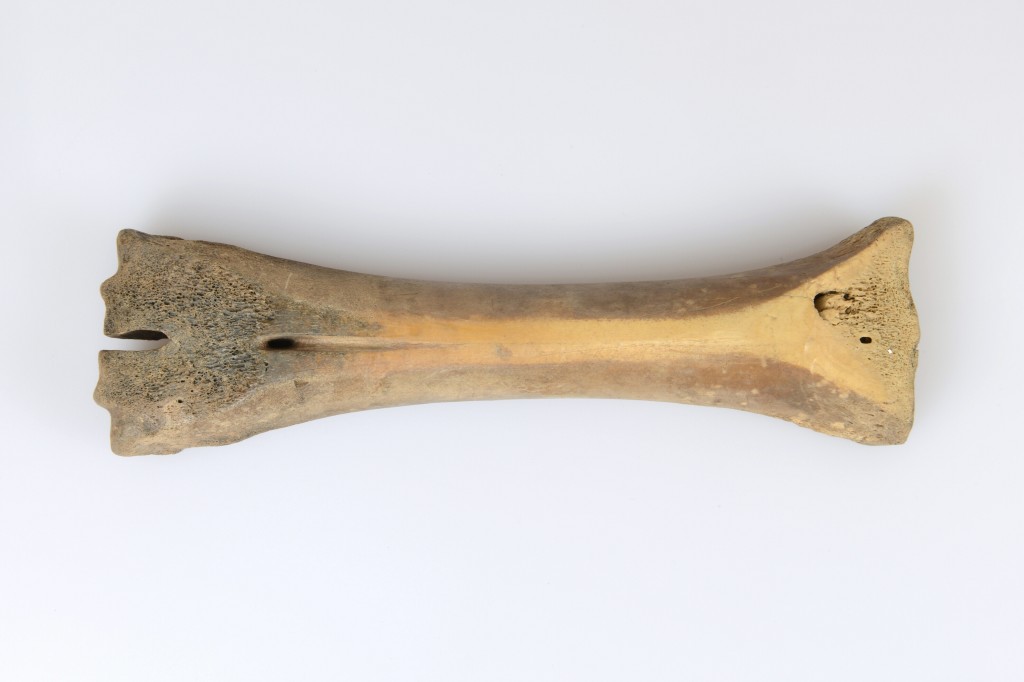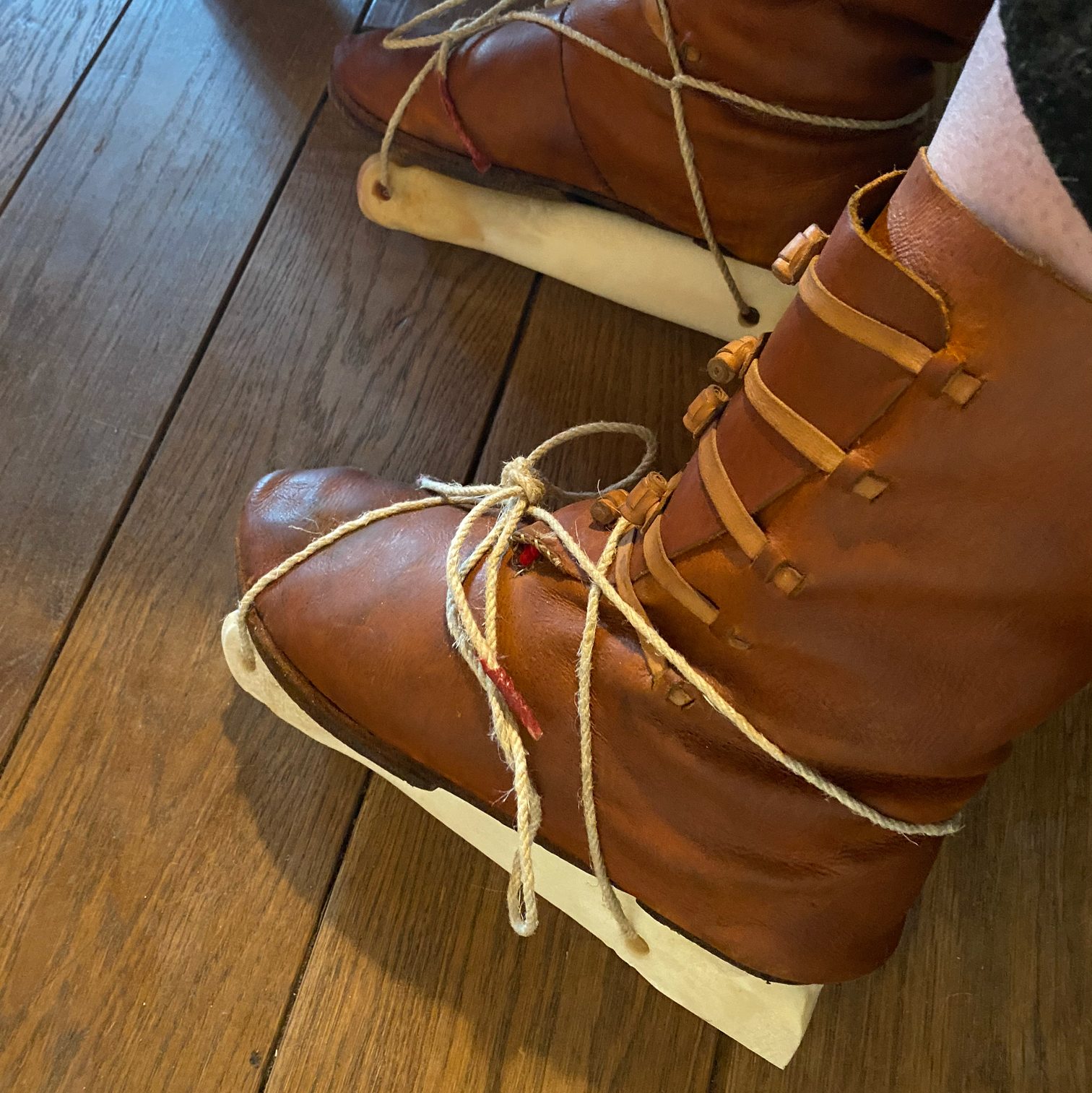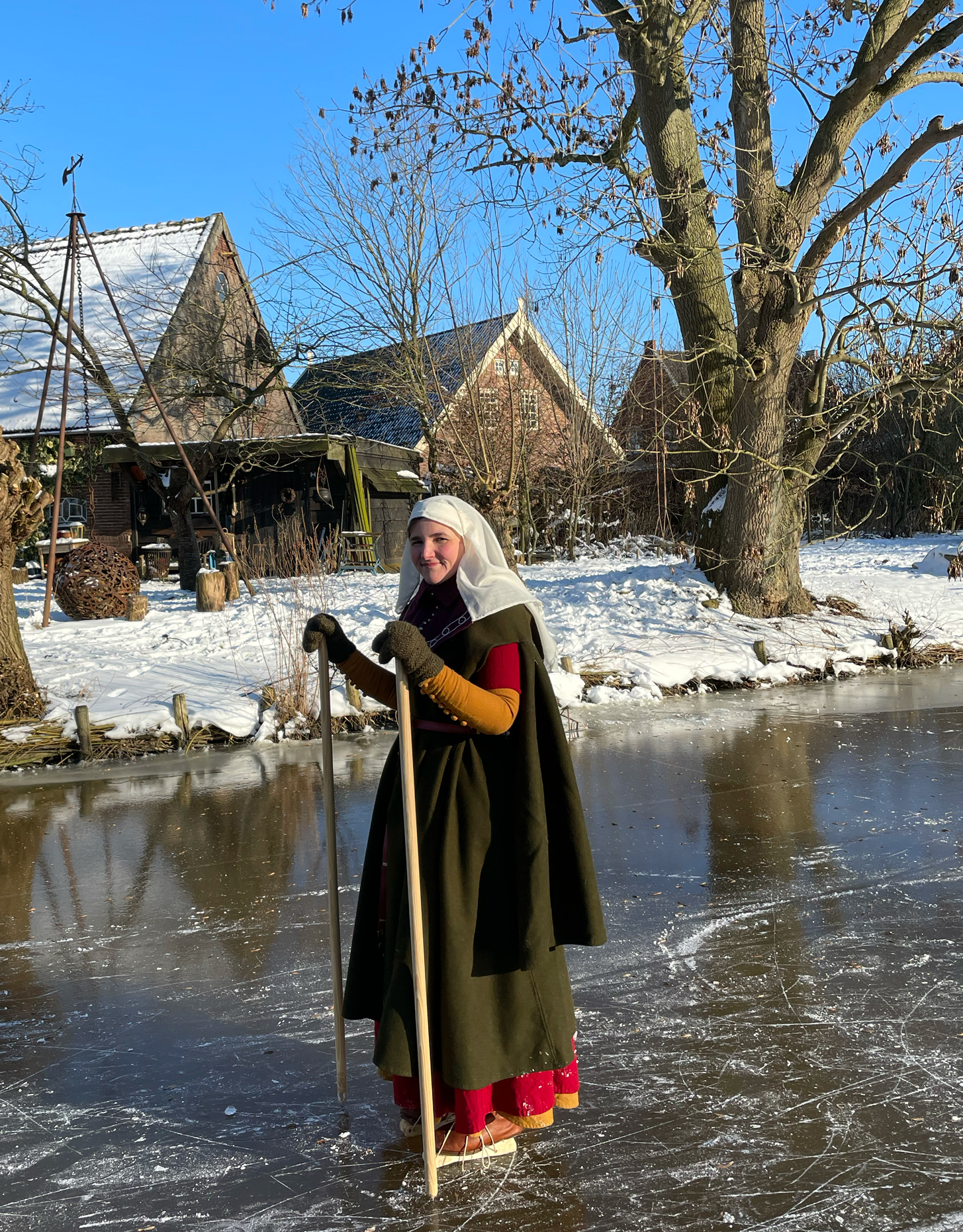This starts about 5 years ago when I found bone runners on a website selling medieval replica’s. I instantly bought them with the idea that it would be really nice to glide on the ice in medieval attire. What I did not know was that for 5 years there would be no natural ice in the Netherlands. The bone runners were becoming dusty on my attic until February 2021. I have bound them under my shoes and went for it. Here I will write about this experience.
A small introduction
First some short information about bone skates. I will keep it brief, but there is a lot of sources I will recommend for further reading.
Glissen is a dutch name for bone predecessors of ice-skates. I will use glissen the rest of this article instead of bone-runners. Leg bones from cattle or horses were often used. One side was flattened, and in some cases the front was tapered so it has a curve upwards. Most founds have holes drilled In the sides for fastening with rope, but other variations are found as well. 1
When searching in the archeological websites of several provinces of the Netherlands several bone skates pop up dating from 750 to 1500. Most of them have drill holes for a string to attach them to your shoes, but some are only flattened. This could mean that maybe they could be used in another way as well.

When you fasten them under your shoes you have gliders for on the ice. With one or two sticks you can glide over the ice, which is faster than walking (and more fun). Archeologists are now thinking that glissen were mostly for children and young adults and can be seen more as play than need. This is because of the small sizes that are found. 3

Usage of these glissen is not widely described in historical sources as far as I know. I did find a mention by Fitzstephen in his “description of the most noble city of London” from the 12th century. Following is a citation from a translation into modern English:
“When the great marsh that washes the north wall of the city is frozen over, swarms of young men issue forth to play games on the ice. Some, gaining speed in their run, with feet set well apart, slide sideways over a vast expanse of ice. Others make seats out of a large lump of ice, and whilst one sits thereon, others with linked hands run before and drag him along behind them. So swift is their sliding motion that sometimes their feet slip, and they all fall on their faces. Others, more skilled at winter sports, put on their feet the shin-bones of animals, binding them firmly round their ankles, and holding poles shod with iron in their hands, which they strike from time to time against the ice, they are propelled swift as a bird in flight or a bolt shot from an engine of war. Sometimes, by mutual consent, two of them run against each other in this way from a great distance, and, lifting their poles, each tilts against the other. Either one or both fall, not without some bodily injury, for, as they fall, they are carried along a great way beyond each other by the impe- tus of their run, and wherever the ice comes in contact with their heads, it scrapes off the skin utterly. Often a leg or an arm is broken, if the victim falls with it underneath him; but theirs is an age greedy of glory, youth yearns for victory, and exercises itself in mock combats in order to carry itself more bravely in real battles.“5
This is only one textual source and will not prove it was only used for fun and games by youngsters, but it does mean winter fun was also part of the usage of glissen, at least in the 11th century in London. (oh history, finding one source actually means nothing 😉 )
Gliding on glissen myself
The glissen are made by bikkel en been https://bikkelenbeen.com. A dutch boneworker who makes replica’ s of various archeological objects made from bone. The type are metatarsus bones with two holes drilled in them. Through these holes runs rope with which the glissen van be fastened to the shoes. Because there are also glissen with iron inserts at the back there probably was not one method of lacing the glissen onto your feet. I tried several options and this was the most stable for now.

As mentioned in descriptions people used two or one stick with a metal point to push themselves forward on the ice. I used two sticks and that worked rather good. What I did experience was that the shape of my glissen can get stuck on little irregularities on the ice. The place where I did skate is a very crowded skating spot. You can see the marks on the ice and that could affect the gliding capacity of the ice. Ice quality could have a huge impact on the performance with glissen. Another type of glissen has a curve up at the front and maybe that works better. I also tried the one stick method while wearing my male kit and although I did glide forward it wasn’t as easy as the two stick method. It should be mentioned that it was starting to thaw that day.



Further thoughts
The gliding with sticks went quite well. I did not get the hang of the one stick method. Maybe that works better with glissen with a curved front. The glissen did wear down a bit and it would be interesting to know how long a pair of glissen would be used, before worn down too much. The archeological finds often are worn down so the centre of the bone starts to get visible.
Sources and further reading
1. Schaatshistorie.nl | Bone skates. (z.d.). schaatshistorie. van https://www.schaatshistorie.nl/english/the-skate/bone-skates/
2. Rijksdienst voor het Oudheidkundig Bodemonderzoek (ROB) (Uitvoerder onderzoek). (z.d.). 6074-02 [Foto]. http://collectie.huisvanhilde.nl/?query=Records/relatedid=%5BObject40757%5D&label=Zoekopdracht&showtype=record
3. Bone skates and young people in Birka and Sigtuna Edberg, Rune & Karlsson, Johnny http://kulturarvsdata.se/raa/fornvannen/ html/2016007 Fornvännen 2016(111):1 s. 7-16 Ingår i samla.raa.se
4. Archeologisch depot Noord-Holland. (z.d.). 6157-04 [Foto]. Huis van Hilde. http://collectie.huisvanhilde.nl/?query=Records/relatedid=%5BObject46303%5D&label=Zoekopdracht&showtype=record
5. Excerpt from English Historical Documents 1042–1189, edited by David C. Douglas and George W. Greenaway (New York: Oxford University Press; London: Eyre & Spottiswoode, 1953), Volume II, pp. 956–961
skating on bones. (z.d.). knochenarbeit. https://www.knochenarbeit.de/skating-on-bones/
Thurber, B. A. (2020). Skates Made of Bone. Macmillan Publishers.

